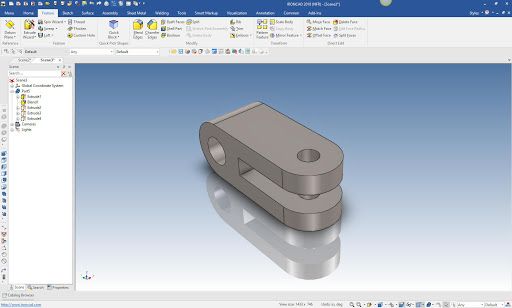
Constraints
Over the past few weeks I’ve been teaching myself how to use Autodesk’s Fusion 360. Fusion 360 is an amazing software package written primarily for mechanical engineers. It incorporates a CAD (computer assisted design) program for making drawings of anything from a small screw to a giant imaginary spaceship. In this, it performs like Autodesk’s earlier program AutoCAD, or the popular Sketchup. But it also incorporates CAM (computer assisted manufacturing) software, which allows you to use your design to control machines that will actually produce the object you imagined, whether through a CNC (computer numeric control) milling machine, or an additive 3D printer.

Fusion 360 is an unbelievably complex program, and there are legions of engineers whose life work is spent inside of it. If you are new to the program, one of the things you don’t at first understand is the concept of constraints. In a simple drawing program like PowerPoint, or even a more sophisticated one like Adobe Illustrator, you can draw figures anywhere you want, move them, modify them, or add to them at will. This doesn’t work in Fusion 360 because the figures have hidden constraints. Once you draw a rectangle you can’t change the corner angles, or set the parallel sides at different angles. The purpose of these constraints is to mimic the behavior of physical objects in the real world: just as you can’t move your hand through a metal plate, neither can you move the representation of your hand through a plate in Fusion. This is what allows you to create software versions of, for example, a piston being moved up and down by a crankshaft, or to test whether parts with the dimensions you specified will actually mate with one another. (If you want to get a sense of constraints in Fusion 360, see this YouTube tutorial by Paul McWhorter.)
___STEADY_PAYWALL___
Fusion 360 is unusual in the way it imposes constraints. Much of the online world is characterized by lack of constraints. There are many software programs where you can, in effect, move your hand through a steel plate. Online, you can talk to anyone you want, free of the tyranny of distance. Because so much online interaction is anonymous, you are also free of the normal constraints of civility that characterize face-to-face interactions. This is all the more true of the gaming world. If you play a first-person shooter game like Call of Duty, you are given a physically endowed body, limitless energy, and the ability to move effortlessly. Life’s most important constraint is the fear of death, or death itself. But in online gaming you don’t have to worry about being killed; if that happens, you just get a new life. Nor does taking lives have any consequences either: you aren’t arrested and put in jail. You get to try out new activities like spraying a room full of people with machinegun fire and committing mass murder. Online gaming blends seamlessly with the plague of superhero movies that Hollywood has churned out, where all men have bulging muscles and all women have gigantic breasts.
In watching the pro-Trump rioters who attacked Congress on January 6, it occurred to me that we have produced an entire generation that has grown up not just on Facebook, but in this gaming/superhero world where normal constraints do not exist. It is notable how gaming memes have proliferated among right-wing groups, like Pepe the Frog or the Red Pill.

Creating new memes has itself has become a way of advancing in that hierarchy, as Tara Isabelle Burton has documented in her book Strange Rites. From the many background reports and interviews with participants in the riot, it would appear that very few of them were unemployed factory workers angry about their jobs has been exported overseas. Many seemed to be middle-class men and women with steady but perhaps boring jobs and marriages. They were living in right-wing filter bubbles, yes, but many of the younger ones were also living in an online gaming world in which normal constraints did not apply. It seemed that many of them had a hard time distinguishing between online fantasy and the real world, driven as they were by QAnon conspiracy theories and hidden signal from their President, Donald Trump. Most had no real plan for what they would do when they got into the Capitol, because you don’t really need a plan when you play an online shooter game. Many of them were busy taking selfies and boasting about their experiences, oblivious of the fact that they were providing evidence that would be used to charge them with crimes.
This is part of a much broader phenomenon that Adam Garfinkle has recently called the "Collapse of Reality" in these pages. We are used to being fed a continuous stream of engaging spectacles. We increasingly don't have direct experience of reality that is not mediated by a screen, and not influenced by algorithms that are intended to alter our behavior. This narrowing realm of autonomy is masked by the apparent endless expansion of consumer choice that fools us into thinking that we are in fact masters of our environment.
Right-wing politics in the United States used to revolve around policy issues like free trade, immigration, taxes, regulation, and the like. In recent years it has become increasingly detached from specific policy positions. I’m old enough to remember the days when Republicans attacked Obama’s “reset” with Russia as the hopelessly naïve coddling of a dictator. After January 6th, by contrast, a female rioter who had taken a laptop from Nancy Pelosi’s office in the Capitol tried to sell it to the Russians, because they were being helpful to Trump. What we have now on the right instead of commitments to policy and ideology is a cult of personality, and beyond that, devotion to outlandish fantasy stories about a global cabal of Satanists intent on drinking children’s blood. It appears that a substantial part of the Republican Party thinks it is living inside a video game, where they can put their hands through steel plates and overturn national elections. The “metaverse” online world first imagined by the Cyberpunk science fiction author Neal Stephenson in his novel Snow Crash has in fact become reality, or rather has melded with reality in ways much darker than Stephenson—always a hugely imaginative writer—ever himself imagined.
Americans need to return to a world full of constraints. And I need to learn how to use Fusion 360 more effectively.
Photo: By TapTheForwardAssist - Own work, CC BY-SA 4.0, https://commons.wikimedia.org/w/index.php?curid=98668026
American Purpose newsletters
Sign up to get our essays and updates—you pick which ones—right in your inbox.
Subscribe






